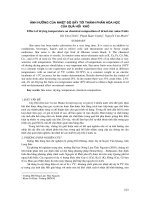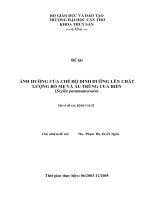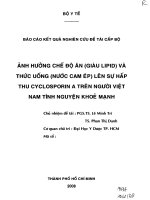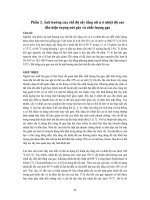Ảnh hưởng của nhiệt độ sấy lên thành phần bay hơi của chè đen OTD
Bạn đang xem bản rút gọn của tài liệu. Xem và tải ngay bản đầy đủ của tài liệu tại đây (419.01 KB, 6 trang )
<span class='text_page_counter'>(1)</span><div class='page_container' data-page=1>
EFFECT OF DRYING TEMPERATURE ON THE VOLATILE COMPOSITION
OF ORTHODOX BLACK TEA
<b>Hoang Quoc Tuan</b>
<b>*</b><b>, Nguyen Duy Thinh, Nguyen Thi Minh Tu </b>
<i><b>Hanoi University of Science and Technology, School of Biotechnology and Food Technology, </b></i>
<i><b>Department of Quality Management, Hanoi, Vietnam </b></i>
<i>Email</i>
<i>*</i><i>: ; </i>
Received date: 20.01.2016
Accepted date: 31.08.2016
ABSTRACT
The effects of drying temperature on the profile of volatile compounds produced by black tea were evaluated at
80, 90, 100, 110, 120, 130, and 140oC. Aroma concentrate was prepared by the Brewed Extraction Method (BEM)
method and analyzed by GC/MS. The volatile compounds content increased as the drying temperature increased
from low to high temperatures. However, the relative content of group II volatile compounds, which are the
degradation products of carotenoids and amino acids, rapidly increased more than the group I volatile compounds
which are mainly the products of lipid breakdown, but when the drying temperature was higher than 120oC, the
relative content of some volatile compounds belonging to group II rapidly decreased more than the volatile
compounds belonging to group I. The highest flavour indice, which is defined as the ratio between desirable to
undesirable volatile compounds, was obtained in samples dried at 120, followed by 110oC. Given the above results,
in the present study, the optimal temperature condition to dry black tea was 120oC or 110oC.
Keywords. Aroma compounds, drying, Vietnam OTD black tea.
<b>Ảnh hưởng của nhiệt độ sấy lên thành phần bay hơi của chè đen OTD </b>
TÓM TẮT
Ảnh hưởng của nhiệt độ sấy đến thành phần bay hơi của chè đen OTD được tiến hành ở các nhiệt độ lần lượt
là 80, 90, 100, 110, 120, 130 và 140°C. Thành phần bay hơi được thu nhận bằng phương pháp chiết nước-dung mơi
và phân tích bằng sắc ký khí khối phổ (GC/MS). Thành phần tương đối của các chất bay hơi nhìn chung tăng lên khi
nhiệt độ sấy tăng. Tuy nhiên, thành phần tương đối của nhóm các chất bay hơi là sản phẩm phân hủy từ nhóm tiền
chất carotenoid và axít amin có xu hướng tăng nhanh hơn so với nhóm các chất bay hơi có nguồn gốc từ q trình
oxi hóa chất béo, nhưng khi nhiệt độ sấy cao hơn 120°C, thành phần tương đối của một số chất bay hơi thuộc nhóm
II bị giảm đi nhanh chóng so với một số thành phần bay hơi thuộc nhóm I. Chỉ số chất thơm (FI), được định nghĩa là
tỉ lệ giữa nhóm chất bay hơi II trên nhóm chất bay hơi I, đạt giá trị cao nhất ở nhiệt độ sấy 120°C và tiếp theo là ở
nhiệt độ sấy 110°C. Theo các kết quả nghiên cứu cho thấy, điều kiện nhiệt độ tối ưu cho quá trình sấy chè đen OTD
là ở 120o<sub>C hoặc 110°C. </sub>
Từ khóa: Chè đen OTD Việt Nam, hợp chất thơm, sấy.
1. INTRODUCTION
Black tea is a fermented tea that is
consumed around the world (Senthil Kumar,
2013). The quality of black tea is due to many
</div>
<span class='text_page_counter'>(2)</span><div class='page_container' data-page=2>
the countries that has high black tea production
in both types of black tea, OTD and CTC.
During the manufacturing process of black tea,
the black tea volatile compounds change
depending on technical parameters. The
purpose of drying is to arrest fermentation and
stop enzyme activities. Further, the aroma
compounds of black tea are balanced during
drying because some of the undesirable
compounds are removed, thus accentuating the
presence of the more useful compounds.
Another purpose of drying is to remove the
moisture content up to 95 - 97% to maximize
the shelf life (Temple and Boxtel, 1999). The
volatile compounds of black tea were
investigated in previous studies by gas
chromatography (GC) and gas
chromatography-mass spectrometry (GC-MS) (Rawat, 2007;
Sereshti <i>et al.</i>, 2013). However, a comparison
of the effect of drying temperatures on
volatile composition of black tea during the
drying processing is not mentioned in any
previous research.
In tea, volatile organic components (VOCs)
are present in very low quantities, i.e. 0.01% of
the total dry weight, but these have a high
impact on the flavour of the products due to
their low threshold value and result in high
odour units. These VOCs can be divided into
two groups. Group I compounds are mainly the
products of lipid breakdown, which imparts an
undesirable grassy odour. However, group II
compounds, which impart a sweet flavoured
aroma to black tea, are mainly derived from
terpenoids, carotenoids, and amino acids. The
aroma quality of black tea depends on the ratio
of the sum of group II VOCs to that of group
I VOCs, which is the flavour index or
volatile flavour compounds (VFC) index
(Ravichandran, 2002).
Therefore, in the present paper, we report
that the change in the volatile composition
during the drying processing of OTD black tea
in terms of group I and group II VOCs as well
as their ratios at different drying temperatures
was extracted by the brewed extraction method
and identified using GC-MS.
2. MATERIALS AND METHODS
<b>2.1. Materials and Experimental </b>
Tea leaves of cultivar PH11, representing
the genetically diverse Northern Vietnam
cultivars, were harvested from Phu Tho province,
Vietnam and were used for manufacturing.
Ten kilograms of young shoots, comprised
of about 70% with two leaves and a bud, plus
minor amounts of three leaves and a bud, and
loose leaves, were plucked. The plucked leaves
were allowed to wither under ambient
conditions for 16 h and then formed into
miniature rolling–dhools. The dhool was
fermented for 180 min at 30 - 35o<sub>C. The </sub>
fermentation was terminated by drying the
dhool to a moisture content of about 3% using a
miniature dryer set at different the
temperatures of 80, 90, 100, 110, 120, 130, and
140o<sub>C inlet (Senthil, 2013). All dried tea </sub>
samples were collected and kept in polymer
bags (200 g/bag) and stored in the dark at room
temperature before analysis.
<b>2.2. Volatile compounds analysis </b>
<i><b>Brewed Extraction Method</b></i>: Twenty
grams of a black tea sample was brewed in 140
ml of deionized boiling water for 10 min. After
filtration, the filtrate was saturated with
sodium chloride and was extracted using 100 ml
of dichloromethane. The extract was dried over
anhydrous sodium sulfate for 1h. After the
sodium sulfate was filtrated out, the solvent
was removed carefully using an evaporative
concentrator. The extraction was carried out in
duplicate for each sample (Kawakami, 1995).
The experimentswerecarried out in duplicate.
</div>
<span class='text_page_counter'>(3)</span><div class='page_container' data-page=3>
mm × 0.25 μm) was equipped, with purified
helium as the carrier gas, at a constant flow rate
of 1 ml min-1<sub>. The oven temperature was held at </sub>
50°C for 3 min and then increased to 190°C at a
rate of 5°C min-1<sub> and held at 190</sub>o<sub>C for 1 min, and </sub>
then increased to 240o<sub>C at a rate 20</sub>o<sub>C min</sub>-1<sub> and </sub>
held at this temp for 3 min. The ion source
temperature was set at 200°C and spectra was
produced in the electron impact (EI) mode at 70Ev
(Lin, 2013). Volatile compounds were identified by
electron impact mass spectrum and similarly
match index. The flavour index was calculated for
each compound expressed as ratio of group II to
group I VOCs.
<b>2.3.Statistical analysis</b>
Principal component analysis (PCA) was
conducted by Multibase_2015, an add-in tool of
Excel version 2010.
3. RESULTS AND DISCUSSION
<b>3.1. Changes in the volatile compounds of OTD </b>
<b>black tea by different drying temperatures </b>
Aroma constituents of various black tea
products are interesting research topics with
potential commercial applications and have
been continually investigated by many
researchers (Pripdeevech and Wongpornchai,
2013). The brewed extraction was employed to
extract volatile flavour components in order to
characterize dried black tea flavour. The
GC-MS profile of the extracted flavours shows the
presence of a wide range of compounds,
including terpenoids, alcohols, acids, aldehydes
and ketones. Table 1 shows the list of volatile
compounds that belong to group I and group II,
which were identified in the dried black tea
obtained from the various drying temperatures.
Most of the compounds have previously been
reported from black tea either on polar or
non-polar GC columns by different extraction
methods such as SDE (simultaneous distillation
extraction), hydro-distillation, and Clevenger
(Rawat, 2007).
In dried black tea, volatile compounds in
both groups increased as drying temperature
increased from 80°C to 120°C and decreased
when the drying temperature was higher than
120°C. The results showed, however, that the
volatile compounds of group II increased more
rapidly than those of group I. This result could
be explained by the flavour index, which
increased from samples dried at 80°C to 120°C.
Many volatile compounds were produced during
drying and their content increased as a function
of drying temperature, especially the
by-products of Maillard reactions, such as
2-acetyl-1-pyrroline and N-ethyl-succinimide, as well as
the degradation products of fatty acids and
carotenoids. The flavour index of samples at
drying temperatures of 130 and 140°C
decreased due to evaporation, and group II lost
more than group I.
<b>3.2. Principal component analysis (PCA) </b>
</div>
<span class='text_page_counter'>(4)</span><div class='page_container' data-page=4>
<b>Table 1.Volatile compounds commonly detected in Orthodox black tea samples </b>
<b>by brewed extraction/GC-MS</b>
No Volatile compounds
Peak area percentage (%)
Drying temperature (°C)
80 90 100 110 120 130 140
Group I*
1 3-hexen-1-ol 2.14 2.34 2.35 2.50 2.61 1.98 1.70
2 hexanal 2.64 2.20 2.24 2.22 2.01 1.51 1.01
3 (E)-2-hexen-1-ol 2.59 2.43 1.79 1.89 3.07 0.76 0.66
4 (E)-2-hexenal 1.88 2.28 1.46 0.70 1.61 0.94 0.37
5 hexanol 1.19 1.22 1.27 1.30 2.77 0.80 0.72
6 nonanal 0.13 0.31 0.84 1.67 1.95 3.25 3.53
7 2-nonanol 0.68 0.61 0.82 0.83 0.74 2.68 3.76
Group II*
8 acetaldehyde 0.19 0.22 0.29 0.37 0.17 nd nd
9 benzaldehyde nd 0.08 0.29 0.29 nd nd nd
10 <i>trans-linaloloxide </i> 0.34 0.70 0.58 0.92 0.18 nd nd
11 β-linalool 0.46 0.51 0.95 1.27 1.74 0.82 0.68
12 benzyl alcohol 3.09 3.01 2.28 2.50 3.53 1.04 0.71
13 benzeneacetaldehyde 1.69 1.73 1.56 1.74 2.80 1.08 0.79
14 phenylethyl alcohol 1.69 1.66 1.54 1.53 2.69 0.89 0.65
15 epoxylinalol 1.35 1.47 1.15 1.10 1.00 0.47 0.38
16 <i>cis-linaloloxide </i> 0.46 0.54 0.76 1.18 1.20 1.04 0.91
17 2-acetyl-1-pyrroline 1.32 1.99 1.43 1.57 1.78 6.36 7.86
18 methyl salicylate 0.14 0.30 0.20 0.23 0.74 0.61 0.52
19 succinimide, N-ethyl- nd 1.03 1.02 1.01 1.08 1.61 1.90
20 <i>trans-geraniol </i> 0.05 0.08 0.10 0.17 0.15 0.05 0.04
21 salicylic acid 0.60 0.63 0.72 0.79 0.86 nd nd
22 β-damascenone 0.29 0.69 0.78 0.87 1.00 0.39 nd
23 benzaldehyde, 4-hydroxy-3-methoxy- 0.29 0.49 0.57 0.71 0.94 0.41 0.03
24 benzeneethanol, 4-hydroxy- 1.36 1.17 1.07 0.84 0.65 nd nd
25 ethyl linalool 1.19 1.22 1.45 0.83 0.77 0.49 0.29
26 3-hydroxy-.beta.-damascone 0.34 0.13 0.29 0.29 0.46 nd nd
27 β-ionone 1.19 1.27 1.41 1.47 2.82 1.08 0.87
28 α-ionone 1.01 1.05 1.27 1.07 2.79 0.73 0.37
29 beta. Ionol 0.55 0.48 0.65 0.78 0.58 0.05 0.02
<i>Group I </i> 11.24 11.40 10.78 11.11 14.76 11.92 11.75
<i>Group II </i> 14.98 17.92 17.49 18.82 25.03 16.52 15.50
Flavour index (Group II/Group I) 1.33 1.57 1.62 1.68 1.70 1.39 1.32
</div>
<span class='text_page_counter'>(5)</span><div class='page_container' data-page=5>
<b>Figure 1. Variables plot between the first 2 PCs </b>
<b>Figure 2. Score plot between the first 2 PCs </b>
The PC1 in the positive axis grouped the
compounds that were observed related to higher
drying temperatures i.e 130 and 140o<sub>C, such as </sub>
nonanal, benzaldehyde, 4-hydroxy-3-methoxy-,
2-acetyl-1-pyrroline, 2-nonanol, β-ionone,
2-hexenal, and (<i>E</i>)- ethyl linalool. Of these,
</div>
<span class='text_page_counter'>(6)</span><div class='page_container' data-page=6>
4-hydroxy-3-methoxy-benzaldehyde, nonanal, 3-hexen-1-ol, β-ionol,
acetaldehyde, benzaldehyde,
4-hydroxy-3-methoxy, and 2-acetyl-1-pyrroline. All these
compounds were grouped on the positive side
and related to samples dried at 110, 120, 130,
and 140o<sub>C. While the compounds salicylic acid, </sub>
(<i>E</i>)-2-hexen-1-ol, and (<i>E</i>)-2-hexenal were found
on the negative axis and related to lower drying
temperatures. The score plot from PC1 and PC2
(Fig. 2) helped to discriminate the treatments
by drying temperature. The treatments at 80,
90, and 100o<sub>C drying temperatures were located </sub>
on the negative side both of PC1 and PC2, while
the treatments at 130 and 140o<sub>C drying </sub>
temperatures were found on the positive side of
both PC1 and PC2, and samples dried at 110
and 120o<sub>C were located on negative side of PC1. </sub>
4. CONCLUSION
The drying temperature process had an
effect on the profile of volatile compounds. In
dried black tea, volatile compounds in both
groups increased as drying temperature
increased from 80o<sub>C to 120</sub>o<sub>C and decreased </sub>
when drying temperatures were higher than
120o<sub>C. The results, however, showed that the </sub>
volatile compounds of group II increased more
rapidly than those of group I. This result would
explain the flavour index which increased in
dried samples at 80o<sub>C to 120</sub>o<sub>C. The flavour </sub>
index of samples at drying temperatures of 130
and 140°C decreased due to evaporation and
group II lost more than group I. In the case of
aroma quality, we recommend an optimal drying
temperature should be arranged from 110 to
120o<sub>C with flavour indices from 1.68 to 1.70. </sub>
Acknowledgments: The authors would like
to thank the Ministry of Education & Training
of Vietnam for providing financial support.
REFERENCES
Senthil Kumar R. S. (2013). Chapter 4 - Black Tea:
The Plants, Processing/Manufacturing and
Production, in Tea in Health and Disease
Prevention, Academic Press, 41 - 57.
Yang Z., Baldermann S., and Watanabe N. (2013).
Recent studies of the volatile compounds in tea<i>.</i>
Food Research International, 53(2): 585-599.
Temple S. J. and Boxtel A. J. B. (1999). Modelling of
Fluidized-bed Drying of Black Tea<i>.</i> Journal of
Agricultural Engineering Research, 74(2): 203 - 212.
Rawat R. (2007). Characterization of volatile
components of Kangra orthodox black tea by gas
chromatography-mass spectrometry<i>.</i> Food
Chemistry, 105(1): 229 - 235.
Sereshti H., Samadi S., and Jalali-Heravi M. (2013).
Determination of volatile components of green,
black, oolong and white tea by optimized
ultrasound-assisted extraction-dispersive liquid–
liquid microextraction coupled with gas
chromatography. Journal of Chromatography A,
1280: 1 - 8.
Ravichandran R. (2002). Carotenoid composition,
distribution and degradation to flavour volatiles
during black tea manufacture and the effect of
carotenoid supplementation on tea quality and
aroma. Food Chemistry, 78(1): 23 - 28.
Kawakami M. (1995). Aroma Composition of Oolong
Tea and Black Tea by Brewed Extraction Method
and Characterizing Compounds of Darjeeling Tea
Aroma<i>.</i> Journal of Agricultural and Food
Chemistry,43(1): 200 - 207.
Lin J. (2013). Discrimination of oolong tea (Camellia
sinensis) varieties based on feature extraction and
selection from aromatic profiles analysed by
HS-SPME/GC–MS<i>.</i> Food Chemistry, 141(1): 259 - 265.
Pripdeevech P. and Wongpornchai S., (2013). Chapter
26 - Odor and Flavor Volatiles of Different Types
of Tea, in Tea in Health and Disease Prevention.
Academic Press: 307 - 322.
</div>
<!--links-->

![[Luận văn]nghiên cứu ảnh hưởng của chế độ nhiệt luyện đến tính chất của hợp kim bimetal thép 5crinimo thép c35](https://media.store123doc.com/images/document/13/gu/la/medium_lad1375972454.jpg)







